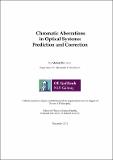| dc.contributor.advisor | Goncharov, Alexander V. | |
| dc.contributor.author | Bahrami, Mehdi | |
| dc.date.accessioned | 2013-05-29T15:11:05Z | |
| dc.date.available | 2013-05-29T15:11:05Z | |
| dc.date.issued | 2012-12-19 | |
| dc.identifier.uri | http://hdl.handle.net/10379/3463 | |
| dc.description.abstract | The variation of refractive index with wavelength, known as dispersion, was what
redirected Isaac Newton from refractive telescope designs toward a reflective one,
since he found the chromatic effect incurable. Later it was shown that different materials
demonstrate different chromatic characteristics and refractive optical elements
can compensate each other's chromatic contributions. This promoted the simple dispersion
effect to the field of formulizing and categorizing chromatic aberrations and
their corrections. In this study an introduction to this process is provided, where the
historical aspects are followed by the mathematical derivation and description of different
kinds of chromatic aberrations accompanied with a variety of approaches to
correct the chromatic effects in different levels. The provided mathematical basis is
employed in studying three distinctive topics. In the first one the flexibility of refractive
elements is used to provide a middle-sized catadioptric telescope design with
all-spherical surfaces. Employing a new combination of chromatic lens correctors,
the image quality can be improved so that it becomes comparable to an equivalent
aspheric Ritchey-Chrétien telescope design. As the second topic the atmospheric dispersion
and its effect in extremely large telescopes are discussed, where a new atmospheric
dispersion corrector design is proposed. In the third task the chromatic behavior
in an inhomogeneous medium is considered. A new gradient refractive index
lens model for the crystalline lens of the eye is established and a different approach
in characterizing its chromatic effects is developed. These three research topics are
underpinning the main goal of the theses, that is the role of chromatic aberration in
image formation in various optical systems. | en_US |
| dc.rights | Attribution-NonCommercial-NoDerivs 3.0 Ireland | |
| dc.rights.uri | https://creativecommons.org/licenses/by-nc-nd/3.0/ie/ | |
| dc.subject | Chromatic Aberration | en_US |
| dc.subject | Telescope Design | en_US |
| dc.subject | Catadioptric System | en_US |
| dc.subject | Atmospheric Dispersion | en_US |
| dc.subject | Atmospheric Dispersion Corrector | en_US |
| dc.subject | Modelling the Eye | en_US |
| dc.subject | Gradient Index Lens | en_US |
| dc.subject | Crystalline Lens | en_US |
| dc.subject | Exact Ray Tracing | en_US |
| dc.subject | Paraxial Optics | en_US |
| dc.subject | Aberration Expansions | en_US |
| dc.title | Chromatic Aberrations in Optical Systems: Prediction and Correction | en_US |
| dc.type | Thesis | en_US |
| dc.contributor.funder | Science Foundation Ireland under grant number 07/IN.1/1906. | en_US |
| dc.contributor.funder | SFI | en_US |
| dc.local.note | The chromatic nature of the light can affect perfect imaging in refractive optical systems. This effect is studied for different optical systems and their surrounding environments to predict the magnitude of the image defects and to suggest correction approaches. The design of middle-sized telescopes with refractive elements is presented. Atmosphere chromatic effect is discussed and our novel chromatic correctors for future extremely large telescopes are examined. A new model of the lens of the eye is developed, and the predictions are compared to the chromatic measurements of the eye. This model also supports analytical optical calculations. | en_US |
| dc.local.final | Yes | en_US |
| nui.item.downloads | 4973 | |


